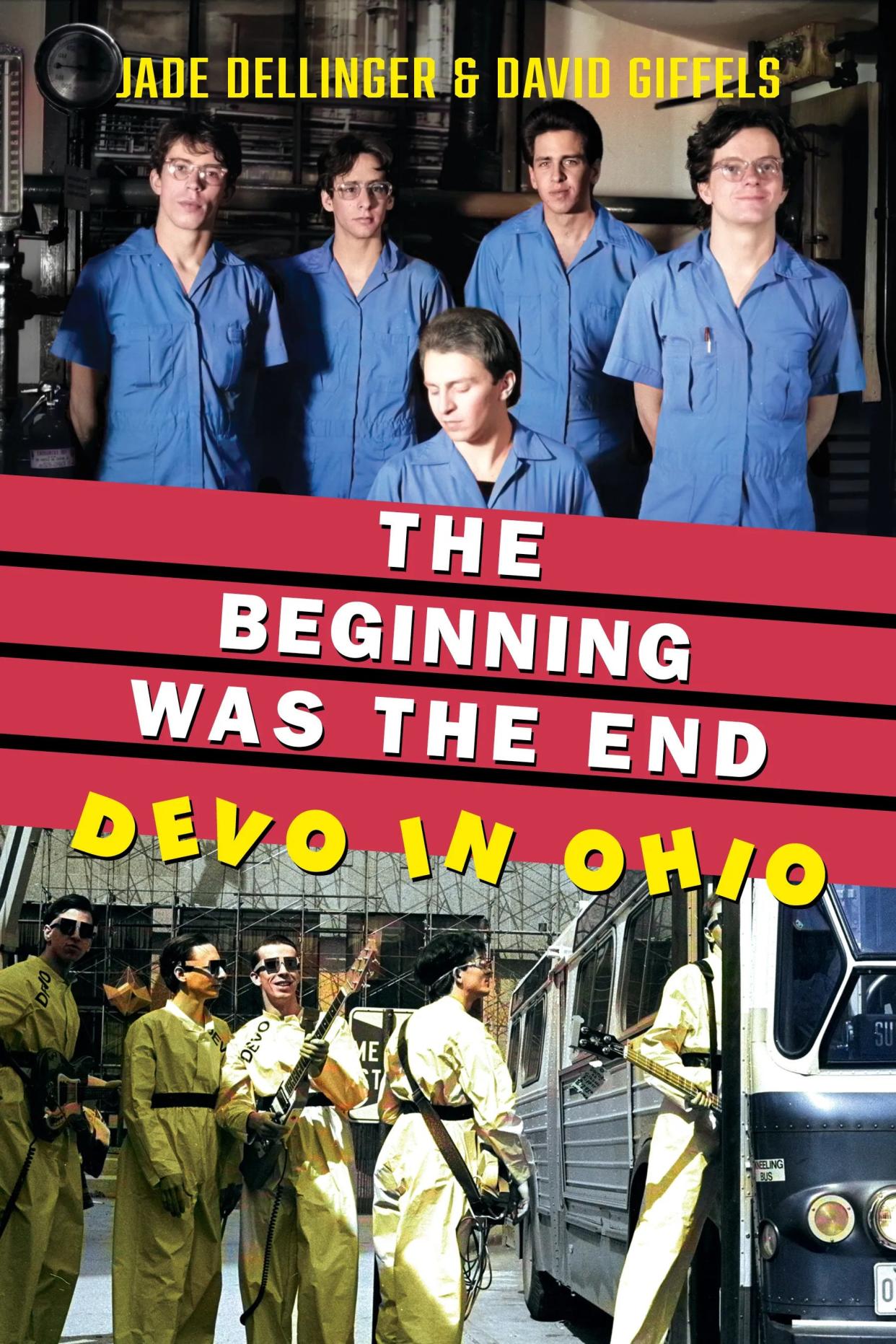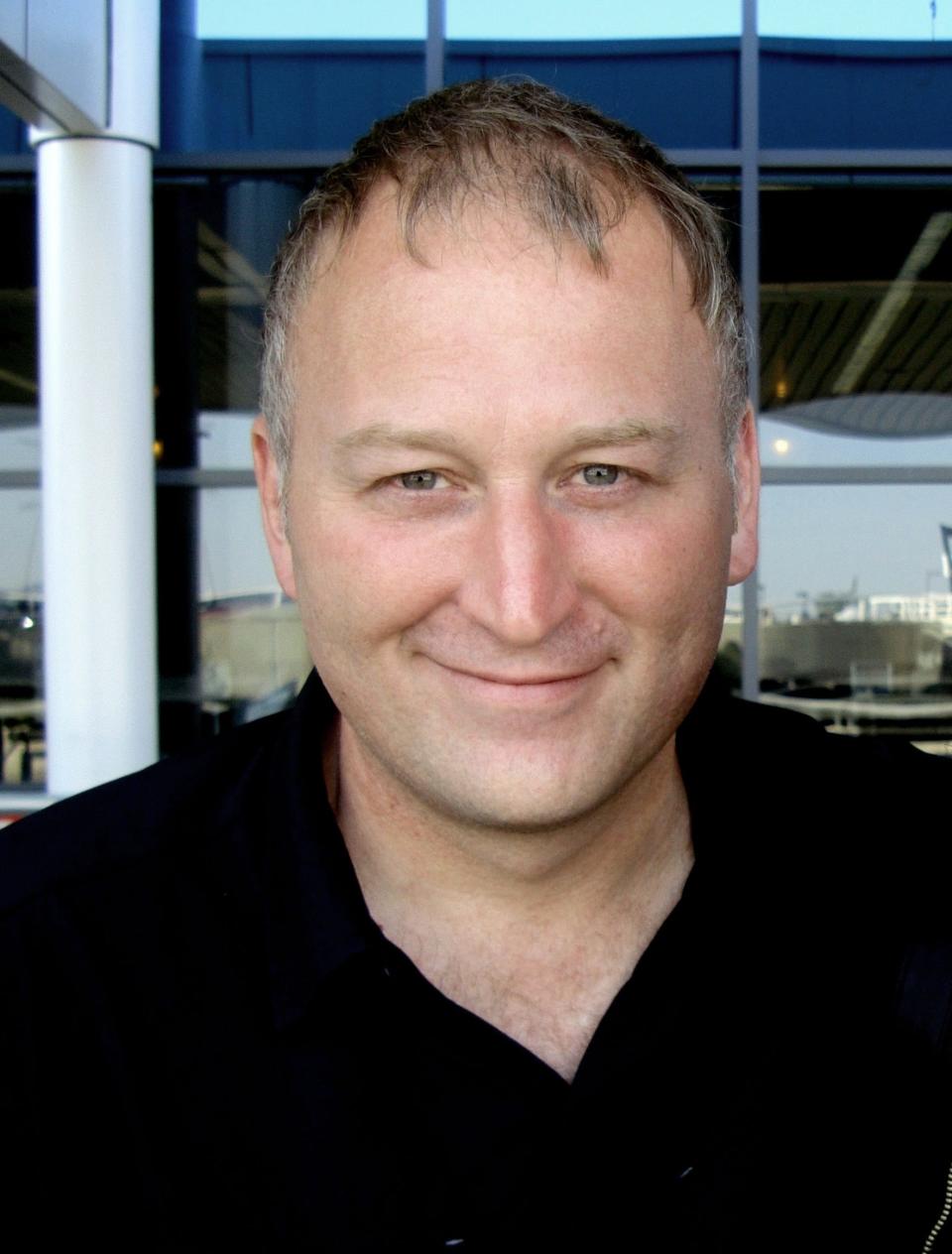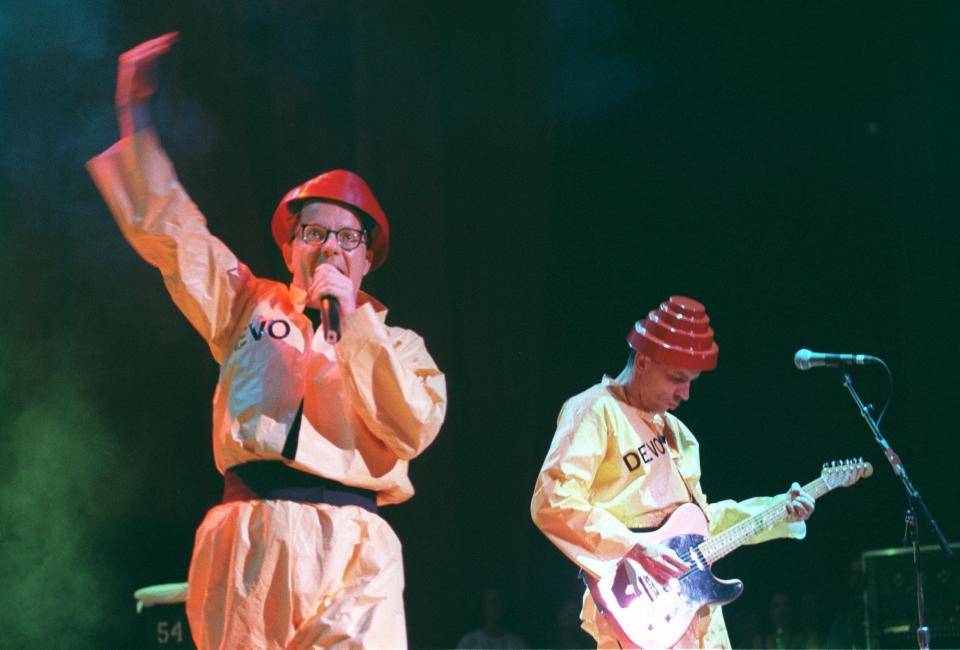Devo authors go back to the future with new book. Learn about the band's Kent roots

Now that Devo has embarked on a farewell tour, it’s the perfect time to look backward. Or forward. Probably both.
Authors Jade Dellinger and David Giffels have teamed up again for “The Beginning Was the End: Devo in Ohio,” an early history of the new wave group from Akron.
Newly released from the University of Akron Press, the 285-page book chronicles the group’s rise from a Kent State art project into musical pioneers of song, video and technology. It’s the unlikely origin story of talented, ambitious artists destined to hit it big with “Whip It” and pave the way for MTV.
“Once they get their record contract and once they start to become pop stars, their story becomes much more paint-by-the-numbers, behind-the-music kind of stuff,” said Giffels, 59, a University of Akron professor of English and a former Beacon Journal reporter. “To me, it’s not nearly as interesting as what came before.”

Gerald Casale and Mark Mothersbaugh formed the iconoclastic group in 1973, and the classic lineup included their brothers Bob Casale and Bob Mothersbaugh, along with Alan Myers.
The band embraced the dystopian theory of de-evolution — that humans are evolving in reverse to a more primitive form — and became famous for yellow jumpsuits, red energy domes and quirky songs.
“The Beginning Was the End” is an abridged, revised edition of the 2003 out-of-print book “Are We Not Men? We Are Devo!” and includes new interviews and more than 80 never-before-seen photos from Dellinger’s collection.
“We decided to take the original text and sharpen its focus on the Ohio years,” Giffels said. “So the book ends really just at the moment that they start to become famous.”
Dellinger, director of the Bob Rauschenberg Gallery at Florida Southwestern State College, is an independent art curator and a major collector of rock memorabilia, including Devo. Giffels met him decades ago at a Devo fan convention, where they learned they had both been conducting independent research for a book on the group.

“We just got to talking and found out that we were both kind of doing this,” Giffels said. “In both of our minds, we’re thinking: ‘There’s not room in the world for two Devo books.’”
So they teamed up, and their working relationship has lasted over 20 years. With this project, Dellinger curated the visual presentation while Giffels worked on editing and rewriting the text.
Giffels is fascinated with the Devo members' prehistory in Akron and Kent as “unknown, super smart, super ambitious, super weird intellectuals” whose ever-evolving art project included music and video.
“Before they ever made a record, they made a film called 'The Truth About De-Evolution,'” he said.
Directed by Chuck Statler, the nine-minute movie was shot in Greater Akron in 1976 and features the band wearing strange masks and performing “Secret Agent Man” and “Jocko Homo.”
“It was groundbreaking,” Giffels said. “Nobody had done a film like that before.”
The book touches on many aspects of the group’s past. The National Guard shootings at Kent State University. Ghoulardi. Sextet Devo. Booji Boy. Goodyear’s World of Rubber. The Crypt. The Akron Sound. General Boy. Highland Square. Quaker Square. Shine On America. CBGBs. Stiff Records. Warner Bros.
Before forming Devo, Casale played drums and bass in The Numbers Band, the legendary Kent outfit founded by Robert Kidney.
“He got kicked out for doing a very Devo thing, which is pulling out a monkey mask one night while they were onstage at JB’s,” Giffels said. “Bob is very serious about the blues and what they’re doing, and he turns around and sees Jerry being absurd and doing his art performance.”
Devo made an infamous appearance in 1975 at the Halloween party for Cleveland radio station WMMS. The headliner was Sun Ra Arkestra.
“Somebody decided to invite this weird band from Akron to open,” Giffels said.
Back then, Devo used an electronic drum set that Jim Mothersbaugh had built from guitar pickups and metal pieces from a muffler shop. One of the world’s first electronic kits, it produced a dissonant, grating, metal-on-metal sound akin to twisted circus music, Giffels said.
“They started playing, and the whole crowd of drunken people in costumes just starts to get pissed at them and starts to taunt them and throw things,” he said.
With rebellious determination, Devo responded by playing louder and more dissonant music, driving away most of the crowd.
“Then poor Sun Ra comes out, and there was nobody left in the auditorium,” Giffels said.
Devo has been nominated three times to the Rock & Roll Hall of Fame in Cleveland but has yet to be enshrined. Giffels said the group should be inducted for pioneering music videos, innovating technology, defining the new wave era and having a lasting impact.
“They had a huge influence on the grunge bands,” Giffels said. “Nirvana covered them. Soundgarden covered them. All of them embraced them as a key influence.”
Iggy Pop has a quote in the book that reinforces the authors' assertion of Devo's importance.
"Where do I see them?" Pop asked rhetorically in the text. "Is there another really creative New Wave band? That's pretty much where I'd see them — as the truth of the New Wave. The actual truth is with that group. The others are more — a song here and a song there, recombinant imagery, skinny ties, paranoia. But I don’t see the creativity matching them.”
Perhaps the rock hall will reconsider.

“The Beginning Was the End: Devo in Ohio” retails for $35.99 from the University of Akron Press.
Giffels and Dellinger will discuss their book at 3 p.m. today at the May 4 Visitors Center in Taylor Hall at Kent State University.
After performing in Europe on a farewell tour, Devo will return to North America in November for a series of sold-out shows in California.
No Ohio dates have been scheduled, but don’t be surprised if that changes.
It would be just like Devo to end where it began.
Mark J. Price can be reached at mprice@thebeaconjournal.com
More: No place like Devo: Gerald Casale revisits childhood home in Kent
More: ‘Christmas Wrapping,’ an unlikely hit for The Waitresses, spreads cheer 40 years later
This article originally appeared on Akron Beacon Journal: Devo authors go back to the future with new book

